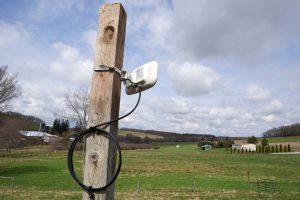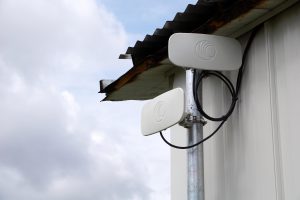$90,000 grant funds infrastructure project for Garrett County broadband installation project
Oakland, MD – Technology can be the great equalizer for individuals, businesses or communities by improving quality of life and increasing access to limitless information. Of course, if you live or work in rural areas or communities where you are cut off from high-speed broadband access, the opposite is true.
Rural communities throughout the nation are challenged to find affordable solutions to an ever-expanding digital divide. In Garrett County, Maryland, the westernmost county in the state, a long-forgotten technology is being repurposed to bridge the divide – unused analog television channels. Referred to as TV White Space, this spectrum is being used along with other wireless technologies to bring high-speed broadband into the community.
A $90,000 Rural Maryland Prosperity Investment Fund (RMPIF) grant is being used to offset the equipment and installation fees for 300 low-income individuals and families who are served by the Garrett County Community Action Committee (GCCAC), the coordinator of the project. Partnering with GCCAC on this project is Declaration Networks Group (DNG) who is providing Internet and voice services under its NeuBeam™ brand.

Garrett County’s scenic terrain provides challenges for affordable Internet access. The Garrett County Community Action Committee in partnership with Declaration Networks Group is tackling that issue with a broadband initiative, which is supported by a $90,000 RMPIF grant.
This grant is one of 28 RMPIF grants totaling more than $1.5 million dollars, which were awarded to 28 organizations for fiscal year 2018. In all, a total of 53 applications were submitted with more than $4.1 million dollars requested. RMPIF grants are managed by the Rural Maryland Council.
“Helping to defray upfront connection costs helps to mitigate barriers for those we serve,” states Duane Yoder, president of GCCAC. This effort to close the digital divide is part of a larger project to bring affordable broadband services to Garrett County, which began in 2015. Like many rural areas affordability of building out the last mile of infrastructure is an issue. However, Garrett County also faces a geographic challenge – its mountainous terrain and heavy foliage, which often interferes with satellite and wireless transmissions.
For Gregan Crawford, vice president of Strategic Initiatives at GCCAC, the project reminds him of rural electrification of the 1930s and 1940s. “We are not simply talking about broadband for entertainment purposes. Rural broadband can enable telemedicine; it allows school children to access the Internet to do homework and research and being connected allows those we serve to perform job searches and enhance their educational opportunities as well,” says Crawford. “We need to start looking at this issue like they looked at electricity in the 1930s and 1940s. It’s got to be considered as infrastructure just as important as other utilities like water and sewer,” he adds.

Fourth grade student Phoenix Mason can easily tackle homework thanks to a RMPIF grant that is offsetting equipment and installation costs.
For VISTA volunteer and project manager Daphne Gooding it’s all making sure that people have access to information. “People who are currently unable to access high speed Internet like low income families are in danger of being left behind,” says Gooding. “We are tapping into our existing network of Head Start families to enroll families into this broadband program. This technology can also reduce overall costs if they bundle a streaming TV and broadband package without the worry of data caps,” she adds.
The grant also includes implementing an educational program so that families can learn how to get the most out of the technology for financial management, improved employment and career development and accessing community resources. Families will also learn how to keep their children safe while they are online.
Infrastructure projects that can positively impact quality of life for rural residents and businesses alike are particularly attractive for the grantor. “Real change usually has a high price tag,” says Charlotte Davis, executive director of the Rural Maryland Council. “Building out the last mile of broadband is a losing proposition for a business, but with wireless technologies and initiatives utilizing a public-private partnership like the project in Garrett County it not only is doable, but also has high potential for lasting impact, making it a win-win for everyone,” she adds.

Shown are two signal devices that are mounted to a barn. The devices are used to relay the signal to the next-door neighbor’s house, which is not in a direct line of a transmitter.
The Rural Maryland Prosperity Investment Fund (RIMPIF) supports the RMC’s activities and the Maryland Agricultural Education and Rural Development Assistance Fund (MAERDAF), which provide capacity-building funds to rural nonprofit service providers. It also supports the states’ five regional councils, regional infrastructure projects, rural entrepreneurship development, rural community development, and rural health care organizations.
FOR IMMEDIATE RELEASE
CONTACT: Carol D’Agostino, (410) 604-2319; carol@purplecatpr.com

 1-888-373-7888
1-888-373-7888 233733
233733